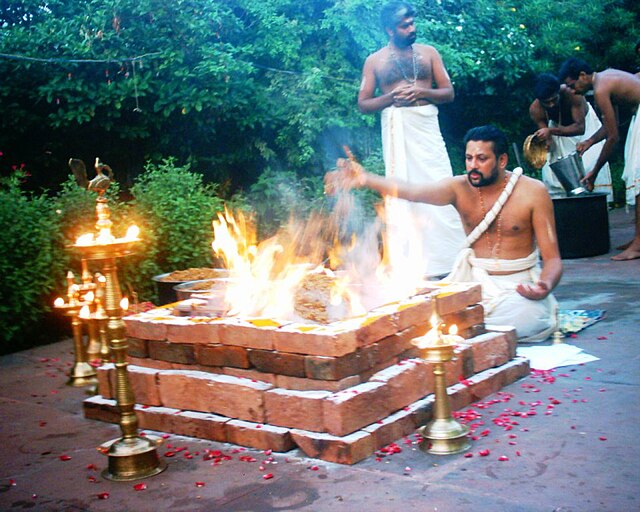યજુર્વેદ
From Wikipedia, the free encyclopedia
Remove ads
યજુર્વેદ (સંસ્કૃત: यजुर्वेद) હિંદુ ધર્મના મૂળ શાસ્ત્ર એવા વેદો પૈકીનો બીજો વેદ છે, જે ગદ્ય શૈલીમાં લખાયેલા મંત્રોનો બનેલો છે.[૧]] યજુર્વેદમાં યજ્ઞ કરતી વખતે યજ્ઞવેદીની સામે બેસીને બ્રાહ્મણ જે મંત્રો બોલે છે તેવા મંત્રોનું અને વિવિધ યજ્ઞો કરવા માટેના વિધિ-વિધાનનું સંકલન છે.[૧] યજુર્વેદનો ચોક્કસ રચનાકાળ જાણી શકાયો નથી, પરંતુ આ વિષયમાં સંશોધન કરનારા મોટાભાગના સંશોધનકારો તેને ઈ.સ.પૂર્વે ૧૨૦૦થી ૧૦૦૦ની આસપાસમાં રચવામાં આવ્યો હોવાનું માને છે, જેનો અર્થ એ થાય છે કે યજુર્વેદ, સામવેદ અને અથર્વવેદના કાળનો જ વેદ છે.[૨]
યજુર્વેદને ખાસ કરીને બે ભાગમાં વિભાજીત કરવામાં આવે છે, કૃષ્ણ યજુર્વેદ અને શુક્લ યજુર્વેદ, જેને અંગ્રેજીમાં અનુક્રમે કાળો (શ્યામ-યજુર્વેદ - "black" Yajurveda) અને સફેદ (સફેદ - યજુર્વેદ - "White" Yajurveda) તરીકે વર્ણવવામાં આવે છે. કૃષ્ણ યજુર્વેદમાં કૃષ્ણ, કે જે કાળા રંગનો સૂચક છે, તેનો અર્થ એ થાય છે કે યજુર્વેદનો એવો ભાગ કે જેમાં મંત્રોની ગોઠવણી અનિયમિત, અસ્પષ્ટ અને પચરંગી છે; જ્યારે તેથી ઉલટું શુક્લ કે જે શ્વેત રંગનો સૂચક છે, એ શુક્લ યજુર્વેદમાં મંત્રો સ્પષ્ટ, નિયમિત અને ક્રમબદ્ધ ગોઠવાયેલા છે.[૩] કૃષ્ણ યજુર્વેદના ચાર સંસ્કરણો મળી આવે છે જ્યારે શુક્લ યજુર્વેદ બે સંસ્કરણોના રૂપમાં સચવાએલો જોવા મળે છે.[૪]
યજુર્વેદની સૌથી જૂની સંહિતામાં ૧૮૭૫ શ્લોકો છે, જે સર્વથા ભિન્ન હોવા છતાં ઋગ્વેદના શ્લોકો પરથી રચાએલા હોય તેવા છે.[૫][૬] તેના બાદનું સ્તર શતપથ બ્રાહ્મણ છે, જે વૈદિક ધર્મના બ્રાહ્મણ શાસ્ત્રોમાં સૌથી મોટો ગ્રંથ છે.[૭] જ્યારે સૌથી તાજી કે નવી સંહિતામાં ઘણાબધા પ્રાથમિક ઉપનિષદોનો સમાવેશ થાય છે, એવા ઉપનિષદો જેમનો હિંદુ તત્ત્વજ્ઞાન/દર્શનશાસ્ત્ર પર ખાસો એવો પ્રભાવ છે. આ ઉપનિષદો છે: બૃહદારણ્યક ઉપનિષદ, ઈશ ઉપનિષદ, તૈત્તિરીય ઉપનિષદ, કઠ ઉપનિષદ, શ્વેતાશ્વતર ઉપનિષદ અને મૈત્રી ઉપનિષદ.[૮][૯]તે હિન્દૂ ધર્મ નો એક મહત્વ નો ગ્રંથ છે
Remove ads
વ્યુત્પત્તિ

યજુર્વેદ શબ્દ બે સંસ્કૃત શબ્દો યજુર્ (यजुस्) અને વેદ (वेद)ની સંધિથી બનેલો શબ્દ છે. વેદનો અર્થ છે, જ્ઞાન. યજુસ્ કે યજુર્ શબ્દનો એક અર્થ થાય છે "ધાર્મિક આદર, પૂજાપાત્ર, આરાધના, બલિ, યજ્ઞ, યજ્ઞમંત્ર, વગેરે".[૧૦] જ્યારે બીજો અર્થ અમુક સંશોધનકર્તાઓ "ગદ્ય કે ગેય" એવો કરે છે.[૧૧]
Remove ads
વિષય
સંહિતાઓ
વાજસ્નેયી સંહિતામાં ૪૦ અધ્યાય છે, જેમાં નીચેની વિધિઓમાં વપરાતા મંત્રોનો સમાવેશ છે:[૧૨] સંદર્ભવિ અધ્યાય ક્રમાંક વિધિનું નામ ૧
| અધ્યાય ક્રમાંક. | વિધિ (કર્મકાંડ)નું નામ | સમયગાળો (દિવસ) | કર્મકાંડનો પ્રકાર | સંદર્ભ |
| ૧-૨ | દર્શપૂર્ણમાસ (પૂનમ અને અમાસની વિધિ) | ૨ | યજ્ઞમાં ગાયનું દૂધ હોમવું. વાછરડાઓને ગાયથી છૂટા પાડવા. | [૧૩][૧૪] |
| ૩ | અગ્નિહોત્ર | ૧ | યજ્ઞમાં દૂધ અને માખણ હોમવું. ત્રણ મૂખ્ય ઋતુઓ (વસંત, વર્ષા અને શરદ)નું સ્વાગત | [૧૫] |
| 4-8 | Somayajna | Bathe in river. Offer milk and soma to fire. Offerings to deities of thought, speech. Prayer to Vishnu to harm no crop, guard the cattle, expel demons. | [૧૬] | |
| 9-10 | Vajapeya and Rajasuya | Cup of Victory, Inauguration of a King. Offering of butter and Sura (a kind of beer or wine) to fire. | [૧૭] | |
| 11-18 | Agnicayana | 360 | Formulas and rituals for building altars and hearths for Agni yajna, with largest in the shape of outspread eagle or falcon. | [૧૮] |
| 19-21 | Sautramani | Offerings of Masara (rice-barley liquor plus boiled millet) to fire. Expiate evil indulgences in soma-drinking. For dethroned king, for soldiers going to war for victory, for regulars to acquire cattle and wealth. | [૧૯] | |
| 22-25 | Ashvamedha | 180 or 360 | Only by King. A horse is released, followed by armed soldiers, wherein anyone who stops or harms the wandering horse is declared enemy of state. The horse is returned to the capital and is ceremoniously slaughtered by the soldiers. Eulogy to the departed horse. Prayers to deities. | [૨૦] |
| 26-29 | Supplementary formulas for above sacrifices | [૨૧] | ||
| 30-31 | Purushamedha | Symbolic sacrifice of Purusha (Cosmic Man). Nominal victim played the part, but released uninjured after the ceremony, according to Max Muller[૨૨] and others.[૨૩] A substitute for Ashvamedha (horse sacrifice). The ritual plays out the cosmic creation. | [૨૪] | |
| 32-34 | Sarvamedha | 10 | Stated to be more important than Purushamedha above. This ritual is a sacrifice for Universal Success and Prosperity. Ritual for one to be wished well, or someone leaving the home, particularly for solitude and moksha, who is offered "curd and ghee (clarified butter)". | [૨૫] |
| 35 | Pitriyajna | Ritual funeral-related formulas for cremation. Sacrifice to the Fathers and Ancestors. | [૨૬] | |
| 36-39 | Pravargya | According to Griffith, the ritual is for long life, unimpaired faculties, health, strength, prosperity, security, tranquility and contentment. Offerings of cow milk and grains to yajna fire. | [૨૭] | |
| 40 | This chapter is not an external sacrifice ritual-related. It is Isha Upanishad, a philosophical treatise about inner Self (Atman, Soul). The verse 40.6 states, "The man who in his Self beholds all creatures and all things that be, And in all beings sees his Self, then he doubts no longer, ponders not. | [૨૮] |
Remove ads
આ પણ જુઓ
બાહ્ય કડીઓ
- વિકિસ્ત્રોત સંસ્કૃત પર यजुर्वेदः
- વેદ-પુરાણ - અહી ચાર વેદો તથા દશ થી વધુ પુરાણ હિંદી અર્થ સહિત ઉપલબ્ધ છે.
- The Texts of the White Yajurveda Ralph Griffith Translation (1899)
- The Yajur Veda – Taittiriya Sanhita AB Keith Translation (1914)
- A Vedic Concordance (includes Yajur Veda), Updated Edition, Harvard University, Bloomfield's Old Edition
- The Taittirīya Sanhitá of the Black Yajur Veda, Rámanáráyana Vidyáratna, Mahesáchandra Nyáyaratna, Satyavrata Sámaśramí
- TITUS Texts Sanskrit text of Vājasaneyi-Saṃhitā
- Die Taittirîya-Samhita 1871
- Sanskrit Web Sanskrit texts of Taittiriya-Samhita,Brahmana,Aranyaka, Ekagni-Kanda etc. with English translations of the Taittiriya-Samhita.
Remove ads
સંદર્ભો
Wikiwand - on
Seamless Wikipedia browsing. On steroids.
Remove ads